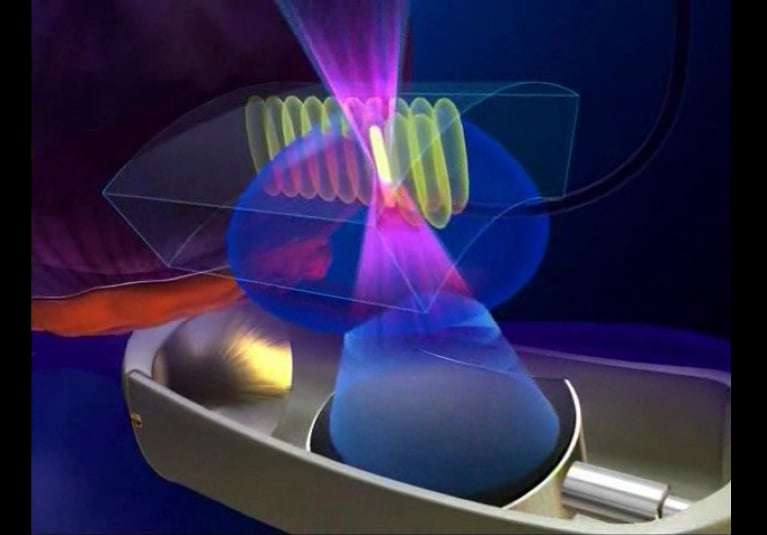Aug. 21, 2021

Derek J. Lomas, M.D., Pharm.D., a urologist and specialist in focal therapy for prostate cancer at Mayo Clinic in Rochester, Minnesota, discusses the addition of high-intensity focused ultrasound (HIFU) to the prostate cancer focal treatment armamentarium.
Provide a little history: How did HIFU progress to a treatment for primary prostate cancer?
The first HIFU prostate cancer clinical trials, completed in the mid-1990s, showed that HIFU could ablate prostate tissue successfully. This finding led to additional studies, and HIFU ultimately entered clinical practice around the world during the following decade.
Initially, HIFU was used to perform whole-gland ablations for prostate cancer. While this application was successful, there was increasing interest in limiting prostate cancer treatment-related side effects by restricting the amount of the prostate that was treated. This treatment approach is termed focal therapy.
The goal of focal therapy is to treat only the area with the most aggressive tumor while leaving the rest of the prostate and its surrounding structures alone. This approach is widely accepted in other types of cancer. For example, we commonly treat kidney cancers by removing or ablating only the tumor while leaving the rest of the kidney intact.
The prostate tumor that is targeted is referred to as the index lesion. In prostates with more than one tumor, this is generally the largest tumor with the highest grade. In these cases, it is believed that the index lesion drives the behavior of the prostate cancer and that treating it alone with focal therapy may lead to good overall cancer control with fewer side effects.
What type of patient is particularly well suited for HIFU?
The ideal candidate for focal therapy typically has intermediate-risk prostate cancer located in only one area of the prostate. This location is determined by prostate magnetic resonance imaging (MRI) and targeted prostate biopsy. My ideal candidate for focal HIFU has a lesion in the posterior or lateral portion of the prostate, a small- to moderate-sized prostate, and no major prostate calcifications or large cysts.
What are the major contraindications to HIFU?
There are a few limitations to HIFU. The first is prostate volume or size. HIFU treatment is delivered through a probe in the rectum, and the treatment can only reach so far away from the rectum. If patients have large prostates and anterior tumors, the energy may not reach anterior enough to provide effective treatment and negative margins. Sometimes tumors in larger prostates can still be treated if the target tumor is in the posterior part of the prostate.
The next limitation is calcifications in the prostate, which are problematic for a couple of reasons. First, the ultrasound energy cannot travel through dense material such as calcifications, so any areas of the prostate behind these may be undertreated. Next, these calcifications can reflect the energy, which could potentially lead to unwanted heat being transferred back to the rectum.
Other potential contraindications include inflammatory bowel disease of the rectum, prior significant rectal surgery, inability to insert the transrectal probe into the rectum, urethral stricture or active infection.
How do you counsel patients who receive HIFU? What is the typical side effect and complication profile? What is the typical recovery?
Overall the focal HIFU procedure is very well tolerated. HIFU is done as an outpatient procedure with a same-day discharge. A Foley catheter is placed during the procedure and is usually left in place for 5 to 7 days following the procedure to allow post-treatment swelling of the prostate to subside.
Once the catheter is removed, most patients do have some temporary obstructive and irritative urinary signs and symptoms including urinary urgency, frequency, slower stream and dysuria. We can manage the signs and symptoms with medications, and patients typically get better within a few weeks.
Rates of new urinary incontinence and erectile dysfunction developing are generally lower than those with prostate removal surgery but are dependent on the location within the prostate being treated. Other side effects that can occur include urinary retention, urinary infection, ejaculatory dysfunction, urethral stricture and rectal fistula (rare).
Most men are able to resume general activities in 1 to 2 days, including regular short walks. More intense physical activity can be resumed once the catheter is removed. There are no incisions to care for or stitches to remove.
Briefly, what are the logistics of the delivery of HIFU?
The HIFU procedure is done while the patient is under general anesthesia. Once the patient is completely anesthetized, a special ultrasound probe is placed in the rectum. There are no incisions or even any needles used. This ultrasound probe is used to both image the prostate and deliver the treatment. Once the initial positioning and planning steps are complete, treatment is delivered.
Each HIFU treatment lasts just a few seconds and destroys an area of tissue that is about the size of a grain of rice. An ablation zone is created by delivering multiple treatments to cover a predefined area of the prostate based on imaging and biopsy results. During the treatment, the surgeon is given real-time imaging as well as treatment parameters including temperature readings and calculated tissue changes to assess the quality and success of ablation. The procedure length depends on the size of the area to be ablated but in general takes approximately two hours.
How do you see HIFU playing a role in prostate cancer treatment over the next 10 years?
I see focal therapy in general becoming an option for more men in the next 10 years as more data supporting its use emerge and more providers become trained in the techniques. HIFU will definitely continue to be one of the main technologies used in prostate cancer focal therapy. There will continue to be ongoing research on other ablation technologies as well. To have a well-rounded focal therapy program, we must have multiple ablation technologies and techniques available to allow for focal therapy to be offered to a wide range of patients. There is still a role for radical prostatectomy and radiation therapy, and certainly they remain the standard of care at this point, but I think focal therapy should at least be part of the treatment discussion in men who are appropriate candidates and seeking a less invasive treatment option.
High intensity focused ultrasound (HIFU) for prostate cancer
HIFU is a treatment that uses high frequency sound waves to destroy prostate cancer cells. The waves create heat that destroys the cancer cells.
You might have HIFU for prostate cancer that hasn’t spread outside the prostate or that has come back in the prostate after treatment. It is only available in specific centres in the UK or as part of a clinical trial.
What is HIFU?
HIFU is a treatment that uses high frequency sound waves. You have HIFU from a machine. The machine gives off sound waves which deliver a strong beam to the cancer. This heats up and destroys the prostate cancer cells.
Who can have HIFU?
The National Institute for Health and Care Excellence (NICE) recommends using HIFU for prostate cancer only in specific centres or as part of clinical trials. NICE is an independent organisation that provides guidance to the NHS to improve healthcare.
Your doctor might recommend HIFU if your cancer:
- is contained inside the prostate gland. This is localised prostate cancer
- is just breaking through the covering of the prostate. This is locally advanced prostate cancer
- has come back after earlier treatment. This is salvage treatment
You can’t have HIFU if your cancer has spread to other parts of your body. This is metastatic or advanced prostate cancer.
You might have HIFU treatment to either:
- the whole prostate gland. This is whole prostate HIFU
- specific areas of the prostate gland. This is focal HIFU
Before your treatment
Check your appointment letter for any specific ways to prepare for HIFU. You have HIFU treatment at the hospital as an outpatient. This means you can usually leave on the same day that you have HIFU.
You might have an MRI scan before the treatment. This is to find the exact position of the cancer so doctors can plan your treatment.
You have an enema to empty your bowels. An enema is a liquid filled pouch with a nozzle that you put into your back passage (anus). This causes you to empty or bowels. Or you take a laxative drink.
You usually need to stop eating for 6 hours before the procedure but can still drink fluids. You stop drinking 4 hours beforehand.
Your doctor asks you to sign a consent form to say that you agree to have the treatment. This is a good time to ask all the questions that you have.
You change into a hospital gown before the procedure.
During HIFU
You have HIFU in the operating theatre under general anaesthetic. This means that you are asleep and won’t feel anything. You have a small tube (cannula) put into a vein in the back of your hand.
Your surgeon puts a thin tube into your bladder through the urethra. The urethra is the tube that carries wee (urine) from the bladder out of the body. The tube drains your urine. It is called a urinary catheter.

Your surgeon puts a HIFU probe into your back passage (rectum). This probe gives out high intensity ultrasound waves that can destroy the cancer cells in your prostate. The high intensity ultrasound waves travel through the back passage to the prostate.
The probe also works as an ultrasound and makes a picture on a screen. This shows your surgeon where they need to target. They move the HIFU probe around to treat all of the cancer cells.
Whole prostate HIFU treatment takes about 3 hours. HIFU to a smaller area (focal HIFU) takes 1 to 2 hours.
When you are fully awake you go back to the ward to rest. The nurses check on whether you have any pain and will give you painkillers if you need them.
After your treatment
When you have recovered from the anaesthetic you can go home, usually on the same day. You won’t be able to drive home after the general anaesthetic. This is because it takes some time for the anaesthetic to wear off.
You might have a catheter for up to a week to drain urine. If you go home with a catheter your nurse will teach you how to care for it. They will arrange for it to be removed.
Side effects
Your doctor explains all the potential side effects to you before you sign the consent form.
All treatments have side effects and it’s important that you know about them before HIFU. You might have some of these side effects.
Pain
You might have pain in the area between your testicles and back passage (rectum). You can take painkillers to help.
Blood in your urine
You might have some blood or small pieces of prostate tissue in your urine. This can last for a few weeks.
Erection problems
At first you might have difficulty having or keeping an erection. For many men this goes back to normal. Treatments can help with erection problems.
Urine infection
Signs of a urine infection include pain passing urine or feeling cold or shivery.
Contact your treatment centre straight away if you have any of these signs or if your temperature goes above 38°C. Severe infections can be life threatening.
Problems passing urine
You might have problems passing urine if the prostate swells after HIFU. The swelling can block the urethra (the tube carrying urine from your bladder to outside your body). This might happen straight after removing your catheter. It is called urinary retention.
Tell your doctor straight away if you can’t pass urine at all. Or go to your local A&E department.
You might need to have a catheter for a short time to drain the urine.
You doctor may suggest that you learn how to put in a catheter to drain your urine at home. This is called self catheterisation. You take the catheter out when the bladder is empty. Your nurse will teach you how to do this.
Infection in your testicles
Infection can start in the small tubes that carry sperm from the testicles. You might have:
- swelling in one or both of your testicles
- pain or tenderness in one or both of your testicles
Tell your doctor or nurse if you have swelling or pain. You might need antibiotic tablets.
Long term side effects
Possible long term side effects include:
- erection problems
- loss of control of urine (urinary incontinence)
- problems passing urine due to blockage of the urethra
- a hole between the bladder and the back passage – this is rare
HIFU and clinical trials
HIFU is not available in every hospital. Your doctor might offer you HIFU treatment as part of a clinical trial. Or you might need to travel to specialist centre for treatment.



